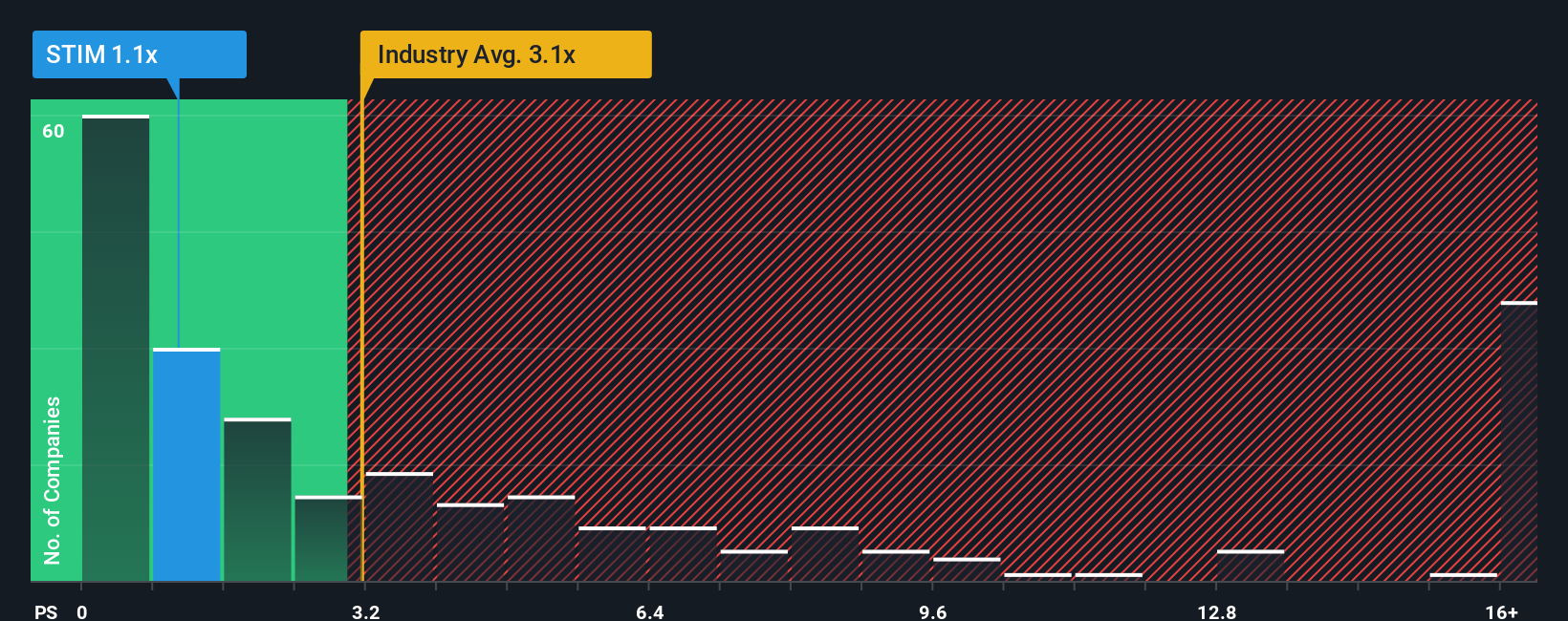- United States
- /
- Medical Equipment
- /
- NasdaqGM:STIM
Slammed 29% Neuronetics, Inc. (NASDAQ:STIM) Screens Well Here But There Might Be A Catch
To the annoyance of some shareholders, Neuronetics, Inc. (NASDAQ:STIM) shares are down a considerable 29% in the last month, which continues a horrid run for the company. The good news is that in the last year, the stock has shone bright like a diamond, gaining 158%.
After such a large drop in price, Neuronetics may look like a strong buying opportunity at present with its price-to-sales (or "P/S") ratio of 1.1x, considering almost half of all companies in the Medical Equipment industry in the United States have P/S ratios greater than 3.1x and even P/S higher than 8x aren't out of the ordinary. However, the P/S might be quite low for a reason and it requires further investigation to determine if it's justified.
View our latest analysis for Neuronetics

What Does Neuronetics' P/S Mean For Shareholders?
With revenue growth that's superior to most other companies of late, Neuronetics has been doing relatively well. Perhaps the market is expecting future revenue performance to dive, which has kept the P/S suppressed. If you like the company, you'd be hoping this isn't the case so that you could potentially pick up some stock while it's out of favour.
Keen to find out how analysts think Neuronetics' future stacks up against the industry? In that case, our free report is a great place to start.What Are Revenue Growth Metrics Telling Us About The Low P/S?
There's an inherent assumption that a company should far underperform the industry for P/S ratios like Neuronetics' to be considered reasonable.
If we review the last year of revenue growth, the company posted a terrific increase of 79%. The latest three year period has also seen an excellent 109% overall rise in revenue, aided by its short-term performance. Therefore, it's fair to say the revenue growth recently has been superb for the company.
Turning to the outlook, the next three years should generate growth of 16% per annum as estimated by the three analysts watching the company. That's shaping up to be materially higher than the 9.3% per year growth forecast for the broader industry.
In light of this, it's peculiar that Neuronetics' P/S sits below the majority of other companies. It looks like most investors are not convinced at all that the company can achieve future growth expectations.
What Does Neuronetics' P/S Mean For Investors?
Shares in Neuronetics have plummeted and its P/S has followed suit. While the price-to-sales ratio shouldn't be the defining factor in whether you buy a stock or not, it's quite a capable barometer of revenue expectations.
A look at Neuronetics' revenues reveals that, despite glowing future growth forecasts, its P/S is much lower than we'd expect. There could be some major risk factors that are placing downward pressure on the P/S ratio. While the possibility of the share price plunging seems unlikely due to the high growth forecasted for the company, the market does appear to have some hesitation.
There are also other vital risk factors to consider and we've discovered 3 warning signs for Neuronetics (2 are significant!) that you should be aware of before investing here.
It's important to make sure you look for a great company, not just the first idea you come across. So if growing profitability aligns with your idea of a great company, take a peek at this free list of interesting companies with strong recent earnings growth (and a low P/E).
Valuation is complex, but we're here to simplify it.
Discover if Neuronetics might be undervalued or overvalued with our detailed analysis, featuring fair value estimates, potential risks, dividends, insider trades, and its financial condition.
Access Free AnalysisHave feedback on this article? Concerned about the content? Get in touch with us directly. Alternatively, email editorial-team (at) simplywallst.com.
This article by Simply Wall St is general in nature. We provide commentary based on historical data and analyst forecasts only using an unbiased methodology and our articles are not intended to be financial advice. It does not constitute a recommendation to buy or sell any stock, and does not take account of your objectives, or your financial situation. We aim to bring you long-term focused analysis driven by fundamental data. Note that our analysis may not factor in the latest price-sensitive company announcements or qualitative material. Simply Wall St has no position in any stocks mentioned.
About NasdaqGM:STIM
Neuronetics
Engages in providing in office treatments for patients with neurohealth disorders in the United States and internationally.
Good value with low risk.
Similar Companies
Market Insights
Community Narratives




